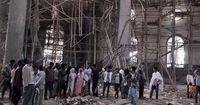In the early hours of October 1, 2025, a devastating tragedy struck the Menjar Shenkora Arerti Mariam Church in Ethiopia’s Amhara region. As thousands of worshippers gathered to celebrate the annual Orthodox Christian festival honoring St. Mary, the church’s makeshift scaffolding collapsed, sending shockwaves through the local community and far beyond. The collapse, which occurred at approximately 7:45 am in the town of Arerti—about 70 kilometers east of the capital Addis Ababa—left a scene of chaos and heartbreak in its wake.
According to local officials and multiple news outlets, the death toll has varied in initial reports, but all agree that the loss of life is staggering. The Associated Press reported that at least 25 people were killed and over 100 injured, while other sources, including state media cited by AFP and BBC, put the number of fatalities at 30 or even 36, with more than 200 people hurt. The victims ranged in age from children to the elderly, underscoring the indiscriminate nature of the disaster.
“So far we have confirmed 25 dead and over a hundred injured,” Seyoum Altaye, a clinician with a local hospital, told AP. He added that children and elderly people were among those who lost their lives or suffered injuries. The hospital, overwhelmed by the influx of wounded, immediately sought support from the Red Cross to help care for the injured. “We are seeking support from the Red Cross to look after the injured,” Altaye explained, highlighting the dire need for additional medical resources and personnel.
As news of the collapse spread, families rushed to the scene, desperately searching for their loved ones amid the tangled debris of collapsed wooden poles and scaffolding. Rescue efforts continued well into the evening, with some people still believed to be trapped under the rubble. The local administrator, Teshale Tilahun, expressed the community’s collective grief and cautioned that the number of casualties could rise further as rescue operations progressed. “It is a tragic loss for the community,” he said, his words echoing the sorrow felt throughout the region.
Eyewitnesses described the incident as sudden and terrifying. Many worshippers had climbed the wooden scaffolding to get a closer look at a ceiling mural—a detail that, in retrospect, only deepened the sense of tragedy. “We all had gathered in prayers when all of a sudden the scaffolding collapsed and people started falling from the ceiling,” said Mikias Mebratu, a survivor who lost three friends in the disaster. The sound of the structure giving way was described as loud and terrifying, with attendees scattering in panic as the reality of the collapse set in.
Local police inspector Ahmed Gebeyehu, speaking to BBC Amharic, confirmed that thousands had been present at the church for the festivities. He noted that the confirmed deceased were aged between 25 and 80, and warned that many more might succumb to their injuries. Some of the severely hurt victims were transferred to larger hospitals in Addis Ababa for advanced treatment, while others continued to receive care at local facilities.
Images shared on the Ethiopian Broadcasting Corporation’s official channels painted a grim picture: a chaotic scene of collapsed scaffolding, crowds of people searching through dense debris, and the somber faces of those awaiting news. The government quickly issued a statement via EBC, offering “deep condolences for the damage caused by the collapse of the scaffolding” and emphasizing that “safety must be given priority” in all construction projects.
This call for greater attention to safety is especially poignant in Ethiopia, where health and safety regulations are poorly enforced and construction accidents are unfortunately common. As AFP noted, the country’s rapid urban expansion has often outpaced the development of regulatory frameworks, leaving many construction sites—both secular and religious—vulnerable to such catastrophes. The government’s statement did not shy away from this reality, urging that “safety must be given priority” to prevent similar tragedies in the future.
The Menjar Shenkora Arerti Mariam Church, like many places of worship in Ethiopia, holds deep significance for the local community. Ethiopia is home to one of the world’s oldest Christian communities, with its roots tracing back to the Axumite Empire, which declared Christianity the state religion in the fourth century. Annual festivals such as the one celebrating St. Mary attract thousands of pilgrims, making the structural integrity of religious buildings a matter of both spiritual and public safety.
Atnafu Abate, a local official, told the Ethiopian Broadcasting Corporation that some people remained trapped under the rubble as of late October 1. He did not provide further details about those still unaccounted for or the ongoing rescue efforts, but the uncertainty only added to the anxiety felt by families and first responders alike. The government’s expression of condolences was accompanied by a renewed commitment to improving safety standards, though many in the community remain skeptical about how quickly or effectively such changes can be implemented.
In the aftermath of the collapse, the focus has shifted to both immediate relief and long-term accountability. Local hospitals, stretched thin by the volume of casualties, have relied heavily on support from the Red Cross and other humanitarian organizations. Meanwhile, questions linger about the cause of the collapse. Authorities have yet to release a definitive explanation, but eyewitness accounts and photographs of the scene suggest that the makeshift wooden scaffolding may have been poorly constructed or overloaded by the large number of worshippers.
The incident has also sparked a broader conversation about construction practices and regulatory oversight in Ethiopia. As the country continues to grow and modernize, the need for robust safety measures becomes ever more urgent. The tragedy at Menjar Shenkora Arerti Mariam Church serves as a stark reminder of the human cost when such measures are neglected.
For now, the community grieves. The annual celebration of St. Mary, meant to be a joyful occasion, has instead become a time of mourning. As rescue workers continue their search and families gather to remember those lost, the hope is that lessons learned from this disaster will lead to lasting change—so that future gatherings can be marked by celebration, not sorrow.







